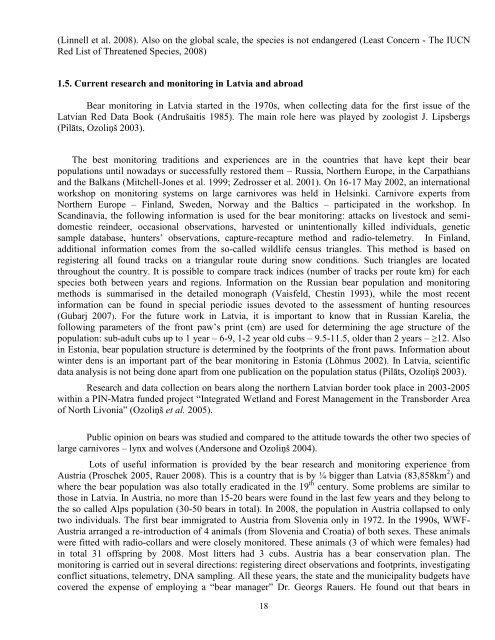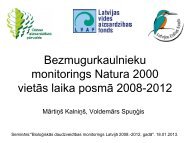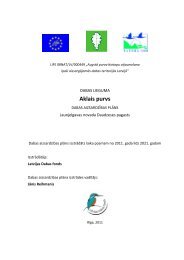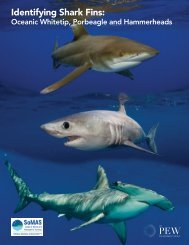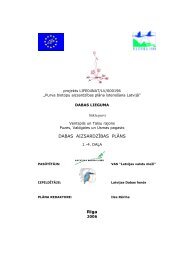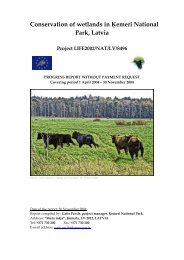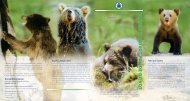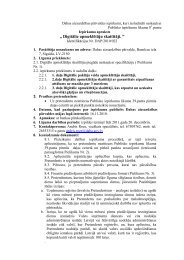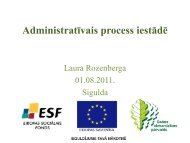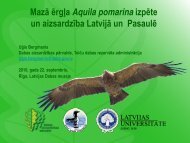Brown bear Ursus arctos - Dabas aizsardzības pārvalde
Brown bear Ursus arctos - Dabas aizsardzības pārvalde
Brown bear Ursus arctos - Dabas aizsardzības pārvalde
You also want an ePaper? Increase the reach of your titles
YUMPU automatically turns print PDFs into web optimized ePapers that Google loves.
(Linnell et al. 2008). Also on the global scale, the species is not endangered (Least Concern - The IUCN<br />
Red List of Threatened Species, 2008)<br />
1.5. Current research and monitoring in Latvia and abroad<br />
Bear monitoring in Latvia started in the 1970s, when collecting data for the first issue of the<br />
Latvian Red Data Book (Andrušaitis 1985). The main role here was played by zoologist J. Lipsbergs<br />
(Pilāts, Ozoliņš 2003).<br />
The best monitoring traditions and experiences are in the countries that have kept their <strong>bear</strong><br />
populations until nowadays or successfully restored them – Russia, Northern Europe, in the Carpathians<br />
and the Balkans (Mitchell-Jones et al. 1999; Zedrosser et al. 2001). On 16-17 May 2002, an international<br />
workshop on monitoring systems on large carnivores was held in Helsinki. Carnivore experts from<br />
Northern Europe – Finland, Sweden, Norway and the Baltics – participated in the workshop. In<br />
Scandinavia, the following information is used for the <strong>bear</strong> monitoring: attacks on livestock and semidomestic<br />
reindeer, occasional observations, harvested or unintentionally killed individuals, genetic<br />
sample database, hunters’ observations, capture-recapture method and radio-telemetry. In Finland,<br />
additional information comes from the so-called wildlife census triangles. This method is based on<br />
registering all found tracks on a triangular route during snow conditions. Such triangles are located<br />
throughout the country. It is possible to compare track indices (number of tracks per route km) for each<br />
species both between years and regions. Information on the Russian <strong>bear</strong> population and monitoring<br />
methods is summarised in the detailed monograph (Vaisfeld, Chestin 1993), while the most recent<br />
information can be found in special periodic issues devoted to the assessment of hunting resources<br />
(Gubarj 2007). For the future work in Latvia, it is important to know that in Russian Karelia, the<br />
following parameters of the front paw’s print (cm) are used for determining the age structure of the<br />
population: sub-adult cubs up to 1 year – 6-9, 1-2 year old cubs – 9.5-11.5, older than 2 years – ≥12. Also<br />
in Estonia, <strong>bear</strong> population structure is determined by the footprints of the front paws. Information about<br />
winter dens is an important part of the <strong>bear</strong> monitoring in Estonia (Lõhmus 2002). In Latvia, scientific<br />
data analysis is not being done apart from one publication on the population status (Pilāts, Ozoliņš 2003).<br />
Research and data collection on <strong>bear</strong>s along the northern Latvian border took place in 2003-2005<br />
within a PIN-Matra funded project “Integrated Wetland and Forest Management in the Transborder Area<br />
of North Livonia” (Ozoliņš et al. 2005).<br />
Public opinion on <strong>bear</strong>s was studied and compared to the attitude towards the other two species of<br />
large carnivores – lynx and wolves (Andersone and Ozoliņš 2004).<br />
Lots of useful information is provided by the <strong>bear</strong> research and monitoring experience from<br />
Austria (Proschek 2005, Rauer 2008). This is a country that is by ¼ bigger than Latvia (83,858km 2 ) and<br />
where the <strong>bear</strong> population was also totally eradicated in the 19 th century. Some problems are similar to<br />
those in Latvia. In Austria, no more than 15-20 <strong>bear</strong>s were found in the last few years and they belong to<br />
the so called Alps population (30-50 <strong>bear</strong>s in total). In 2008, the population in Austria collapsed to only<br />
two individuals. The first <strong>bear</strong> immigrated to Austria from Slovenia only in 1972. In the 1990s, WWF-<br />
Austria arranged a re-introduction of 4 animals (from Slovenia and Croatia) of both sexes. These animals<br />
were fitted with radio-collars and were closely monitored. These animals (3 of which were females) had<br />
in total 31 offspring by 2008. Most litters had 3 cubs. Austria has a <strong>bear</strong> conservation plan. The<br />
monitoring is carried out in several directions: registering direct observations and footprints, investigating<br />
conflict situations, telemetry, DNA sampling. All these years, the state and the municipality budgets have<br />
covered the expense of employing a “<strong>bear</strong> manager” Dr. Georgs Rauers. He found out that <strong>bear</strong>s in<br />
18


